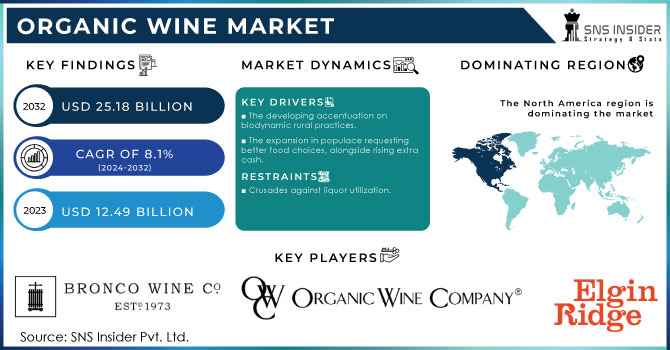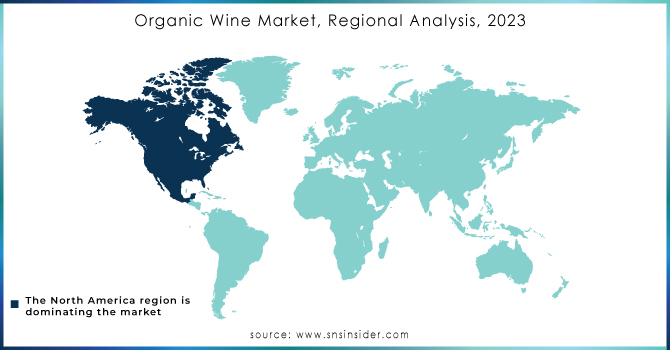Organic Wine Market Report Scope & Overview:

Get PDF Sample Report on Organic Wine Market - Request Sample Report
Organic Wine Market Size was valued at USD 12.49 billion out of 2023 and is expected to reach at USD 25.18 billion by 2032, and grow at a CAGR of 8.1% over the forecast period 2024-2032.
Organic wine is ready from grapes developed as per standards of natural cultivating. It avoids the utilization of fake substance composts, fungicides, pesticides, and herbicides. Organic wine is thought of as sound as it has bunches of cell reinforcements, Vitamins & Minerals. Resveratrol present in red wine is assessed to bring down cholesterol and assist with forestalling malignant growth. Organic wine is managed by a few bodies across the globe, like USDA Organic, Demeter, and Eco-Cert.
The sulfite use in organic wine is extensively lower than in regular wines. To get organic wine ranch affirmation, sulfites should be under 100 mg for every liter or no sulfite by any means during the winemaking stage. Sulfite causes migraine, stomach agony, enlarging, and loose bowels to a specific level of populace drinking wine. organic wine is sans sulfite, which makes it better. This, thus, is supporting the development of the organic wine market.
Also, as organic wines are liberated from added substances like sulfur, yeast supplements, and fine, and created by utilizing native yeasts, the interest is seeing significant development. The shopper’s interest in vegetarian cordial, additive-free, biodynamic, carbon-nonpartisan and guaranteed organic wines has set the ball moving for the development of the organic wine market during the conjecture time frame. The organic wine market is presently a specialty market that is probably going to change into a standard market throughout the forthcoming years. One more component that is projected to assume a vital part in the improvement of the organic wine market is the great ascent in the quantity of wellbeing cognizant buyers who are generally disposed toward buying natural food and drink items.
1 billion liters of excess wine delivered in the European market are probably going to wind up in refineries and Extra tax collection from unfamiliar wine in the Chinese and American business sectors could prompt a 14% drop in wine trades over the course of the year. The world wine market is going through an ocean change. Buyer tastes are changing for lighter wines viewed as more attractive. Likewise, organic wine, which is essential for a drive to "drink less however better", is by all accounts performing great.
Market Dynamics:
Driving Factors:
-
The developing accentuation on biodynamic rural practices.
-
The expansion in populace requesting better food choices, alongside rising extra cash.
Restraining Factors:
-
Crusades against liquor utilization.
Opportunities:
-
Scholastics, retailers, government offices, winemakers, and ranchers are progressively zeroing in on upgrading soil wellbeing and limiting the general carbon impression.
-
Avowable unofficial laws to advance natural grape development.
Challenges:
-
The significant expense and nonattendance of a widespread administrative group of organic wine creation.
Impact of Covid-19:
The COVID-19 pandemic horrendous affects a few significant center modern areas. As café and neighborliness fragments all over the planet have pretty much ground to a halt because of severe control measures implemented by states, the interest in organic wine has endured a significant shot amid the COVID-19 pandemic. While deals of organic wine are probably going to stay drowsy soon, the interest is supposed to observe consistent development in specific districts where lockdown limitations have been loose. The worldwide import and commodity of natural wine are probably going to be in the groove again in the last quarter of 2020, as limitations on exchange and transportation are probably going to be lifted. While disconnected deals are assessed to observe a plunge, market players ought to zero in on expanding deals through web-based circulation channels amid the continuous wellbeing emergency.
Impact of the Ukraine-Russia war:
Long stretches of battling have not just upset — and conceivably put off — Ukraine's abilities to winemaking, yet it likewise unleashed destruction across Eastern Europe's wine store network overall. A few offices have halted creation to help evacuees. Others have experienced expansion and different issues including that transport to bottle supply issues, as threats brought about annihilated stock and impeded Ukraine's primary port of Odesa. The nation likewise saw void wine bottles transformed into weapons, per The Washington Post.
Packaging type:
In light of bundling, the organic wine market is portioned into plastic jugs, glass containers, jars, and others. The glass bottles section represented the biggest portion of the worldwide organic wine market. The other portion is supposed to develop at the most noteworthy CAGR during the conjecture time frame. Glass bottle bundling offers more period of usability and is a major area of strength for exceptionally. Glass bottle bundling follows the speed of market advancement. Glass is the traditional type of bundling for fluid items. Wines can be put away in glass bottles for a long time as it doesn't respond synthetically with wine.
Product type:
In light of item type, the organic wine market is portioned into red organic wine and white natural wine. The red natural wine section represented the biggest offer in the worldwide organic wine market in 2019 and is supposed to enroll the quickest development rate during the figure time frame.
Distribution channel:
In light of the conveyance channel, the organic wine market has been divided into food administration, general stores and hypermarkets, expert retailers, online channels, and others. The grocery stores and hypermarkets portion represented the biggest offer in the worldwide organic wine market. The food administration portion is supposed to enroll the quickest development rate during the conjecture time frame. Stores and hypermarkets are self-administration shops that offer various classes of items. Stores and hypermarkets are considered significant conveyance channels for deals on organic wine items.
Key Market Segmentation:
By Type:
-
Red Organic Wine
-
White Organic Wine
By Packaging:
-
Bottles
-
Cans
-
Others
By Distribution Channel:
-
On-trade
-
Off-trade
Regional Analysis:
-
North America
-
USA
-
Canada
-
Mexico
-
-
Europe
-
Germany
-
UK
-
France
-
Italy
-
Spain
-
The Netherlands
-
Rest of Europe
-
-
Asia-Pacific
-
Japan
-
south Korea
-
China
-
India
-
Australia
-
Rest of Asia-Pacific
-
-
The Middle East & Africa
-
Israel
-
UAE
-
South Africa
-
Rest of Middle East & Africa
-
-
Latin America
-
Brazil
-
Argentina
-
Rest of Latin America
-
Customers in North America are pushing their preferences toward a better way of life and picking normally created things. The utilization of normal and compound-free items has ascended lately as wellbeing cognizant clients have become more mindful of the advantages associated with these items. Organic wine has seen an expansion popular because of this pattern. organic wine is developed and handled by severe rules that boycott the utilization of manufactured manures, pesticides, and an assortment of other fake fixings. In industrialized nations, drinking wine at get-togethers and merriments has turned into a superficial point of interest, which is the major justification for the ascent in wine interest. Moreover, purchasers' high extra cash and the development of special and promoting strategies have supported interest in organic wine. Moreover, North American wineries are continually growing their organic wine portfolio to satisfy client needs.

Get Customized Report as per Your Business Requirement - Request For Customized Report
Key Players:
Avondale, ELGIN RIDGE WINES, The Organic Wine Company, Bronco Wine Company, King Estate Winery, GRGICH HILLS ESTATE, EMILIANA, Società Agricola QuerciabellaSpA, Frey Vineyards, La cantina PizzolatoS.r.l.
| Report Attributes | Details |
|---|---|
| Market Size in 2023 | USD 12.49 Billion |
| Market Size by 2032 | USD 21.56 Billion |
| CAGR | CAGR 8.1% From 2024 to 2032 |
| Base Year | 2023 |
| Forecast Period | 2024-2032 |
| Historical Data | 2020-2022 |
| Report Scope & Coverage | Market Size, Segments Analysis, Competitive Landscape, Regional Analysis, DROC & SWOT Analysis, Forecast Outlook |
| Key Segments | • by Packaging (Plastic Bottles, Glass Bottles, Cans, and Others) • by Product Type (Red Organic Wine and White Organic Wine) • by Distribution Channel (B2B and B2C [Store-based Retailing, HoReCa, and Online Retailing]) |
| Regional Analysis/Coverage | North America (USA, Canada, Mexico), Europe (Germany, UK, France, Italy, Spain, Netherlands, Rest of Europe), Asia-Pacific (Japan, South Korea, China, India, Australia, Rest of Asia-Pacific), The Middle East & Africa (Israel, +D11UAE, South Africa, Rest of Middle East & Africa), Latin America (Brazil, Argentina, Rest of Latin America) |
| Company Profiles | Avondale, ELGIN RIDGE WINES, The Organic Wine Company, Bronco Wine Company, King Estate Winery, GRGICH HILLS ESTATE, EMILIANA, Società Agricola QuerciabellaSpA, Frey Vineyards, La cantina PizzolatoS.r.l |
| Key Drivers | •The developing accentuation on biodynamic rural practices. •The expansion in populace requesting better food choices, alongside rising extra cash. |
| Market Opportunities | •Avowable unofficial laws to advance natural grape development. |

